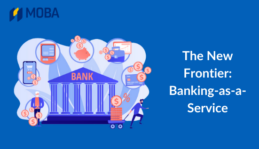Source: KMS Solutions
Digital Banking can offer the best of both worlds. On the one hand, digital banking allows for automation that helps banks save time and costs. On the other hand, it enables the anytime-anywhere banking experience that today’s customers require. Digital banking is no longer the future. It’s now happening across the banking landscape.
But what exactly is digital banking? Is it the same as online banking? And how about mobile banking?
This article provides you with an overview of digital banking: what it is, what it includes, and some other terms you will come across when exploring digital banking.
Digital Banking: What is it?
Digital banking is the digitizing — or moving online — of certain or all banking activities that traditionally happen only inside the banks’ branches.
For banks, digital banking is about applying:
- Process automation to reduce labor and paperwork
- Online services either on the web portal or mobile app to improve customer experience
- APIs to enable partnerships with other service providers.
Simply speaking, digital banking is the ability to access banking services and financial data through devices and platforms such as web portals and mobile apps.
Digital Banking vs. Online Banking vs. Mobile Banking

It’s not uncommon for people to use digital banking interchangeably with mobile banking and online banking. But in fact:
Digital Banking = Online Banking + Mobile Banking
This equation perfectly captures digital banking and what it’s made of.
What is online banking? Online banking means providing banking services and products through the bank’s website. This kind of website — normally called an online banking portal — offers basic features like balance checks, pay bills, and loan applications, …
Online banking was first introduced in 1997 by Sumitomo Bank. And until 2010, almost all banks across the globe had some form of online banking in place.
What is mobile banking? Mobile banking, on the other hand, means providing banking services through the bank’s mobile applications, called mobile banking apps. This app is proprietary, which means it is developed and owned by the bank.
Mobile banking helps banks adapt to the growing penetration of smartphones, which is 78.05% in 2020, a 1.6 increase from 2016.
Nowadays, a typical mobile banking app can act as a service hub, offering most banking services. It also comes with high-security standards.
With mobile banking, banks can send customers banking alerts such as fraud detection and low balance notifications.
In short, digital banking is the combination of online banking and mobile banking.
Who Offers Digital Banking?

There are two primary players in the digital banking arena: traditional banks and neobanks.
Digital banking offered by traditional banks
They are the earliest form of bank, relying majorly on physical establishments to do business. But this status quo is no longer working. Traditional banks are investing in digital banking to adapt to changing consumer preferences and keep up with their digital-only challengers. In a report by Backbase, 63% of customers in APAC say they are willing to switch to neo banks.
The good news is that traditional players have begun to realize the importance of digital banking. Deloitte’s findings revealed that 28% of banks consider “creating digital capability” as a top IT initiative, while 23% prioritize “modern legacy systems”.
Typically, there are two approaches for traditional banks to adopt digital banking:
- Build mobile banking apps or online banking portals from scratch
- Buy ready-built digital banking platforms from a third-party
Digital banking offered by neobanks
Neobank, online bank, virtual bank, or internet-only banks are the same thing.
Unlike traditional banks, neobanks operate exclusively online without a physical branch network. Thanks to this, they can do away with most of the costs associated with renting and managing physical estates. At the same time, neobanks appeal to today’s customers with higher-than-average interest rates and a user-centric customer experience in exchange for no in-branch experience.
However, neobanks’ range of services is typically narrower than traditional banks.
Neobanks can affiliate with one or many traditional banks, working as their digital banking division. Or they can operate independently online.
Digital banking offered by Beta banks
As a joint venture or subsidiary of an existing bank, beta banks offer digital banking services and products through their parent’s license and reputation. A beta bank is intended as a venue for traditional banks to explore new markets. However, a beta bank is typically limited in terms of the services offered.
Digital banking offered by Nonbanks
Nonbanks do not have a full banking license. However, they utilized their digital platforms and reputation to provide or facilitate financial services, mostly through partnerships with existing banks and other types of digital banks discussed so far.
Benefits of Digital Banking

Digital banking offers numerous benefits on two fronts: the bank itself and the customers using digital banking services.
Benefits of digital banking to banks
- Cost savings: To cut costs, banks need to reduce or ideally replace manual labor, which is costly, slow, and error-prone. Manual processes also take up office space, which increases energy and storage costs. Thanks to digital banking, banks can automate repetitive processes and reduce manual labor, which contribute directly to cost-saving. According to McKinsey, digital banking can help traditional banks achieve a 40% increase in EBITDA margins.
- Business efficiency: digital banking is not just about customer experience. With process automation and middleware, digital banking makes internal processes and functions more efficient.
- Increased accuracy: Banks relying on paperwork reported having an error rate of 40%. Not only are the errors costly, but they can damage banks’ reputations. By digitizing the verification process, digital banking helps banks achieve accurate and fast accounting.
- Greater agility: The use of data analytics in digital banking can help banks accelerate both internal and external processes. Instead of hiring and training risk specialists, banks can apply advanced analytics tools to detect and respond to market changes.
- Enhanced security: The banking industry as a whole is criminals’ favourite target. A digital banking model with extra layers of security allows banks to predict and prevent costly malicious attacks.
- Survival: Besides customers and the need to reduce costs, the pressure from nonbanks and fintech companies can prompt banks to change. For traditional players, digital banking is now a matter of survival.
- Customer experience: Digital banking does not mean getting rid of all the physical components. Instead, it is about combining all channels, from physical branches to mobile apps and webs. This enables banks to offer an integrated omnichannel experience, where customers can engage with banks in every way they want.
Benefits of digital banking to customers
- Convenience: For customers, the biggest benefit of digital banking is the ability to access banking services anywhere, anytime and however they want. For example, a mobile banking app lets customers transfer and receive money from everywhere. At the same time, customers can check balances and track every penny they have spent. Digital banking also provides the convenience and security of cashless payment as consumers gradually carry less cash. It’s also eco-friendly, which can appeal to eco-conscious individuals.
- Features: Today’s digital banking experience is rich with features that are personalized to users’ behaviors and preferences. They are integrated with a spending tracker, saving tool, and even a virtual assistant that offer on-demand financial advice. Among them, peer-to-peer payment has been the most popular. The ability to send money to anyone within minutes is attractive to most customers. Coming next are balance checks, mobile deposit checks, fund transfers, or bill pay. Many banks are also providing value-added features such as ATM location, cardless ATM withdrawal, or budgeting and tracking tools.
- Security: Many banks ensure the safety of digital banking by adding multi-factor authentication to their mobile app and online account. In addition, today’s mobile banking apps are integrated with eKYC solutions and biometric authentication (fingerprint, voiceprint, and facial recognition) to ensure security. A mobile banking app can require additional verification if it detects the account is logged from an unknown device.
- Better rates and lower fees: Digital banking services offer lower costs and higher interests in exchange for no in-branch interactions.
Digital Banking Trends for 2022

1. Decisioning and Communication enabled by analytics
Not just limited to producing reports, analytics in digital banking must be able to identify opportunities, support decision-making, and enable personalization. Analytics will not replace humans but enhance and can be improved by humans.
Internally, advanced analytics algorithms can provide visibility into what’s happening across their organization. This helps employees take appropriate actions to improve operations, reduce costs, save time, and enhance customer service.
In digital banking, analytics is the foundation of personalization. Thanks to it, banks can design and provide products tailored to customers’ needs and preferences. Analytics also allows for proactive recommendations at scale and in real-time.
2. The adoption of Open Banking APIs
Every banking leader agrees that Open Banking is the key enabler of digital banking. It shapes technology investment, product development, fintech partnership, data modernization and centralization.
To prepare for the Open Banking evolution, banks must define an appropriate business model. Including the internal digital capabilities and external partnership with third-party providers to make that strategy a reality.
3. The Move to the Cloud
IBM study in 2020 reported that among 91% of financial institutions that applied or planned to apply some form of cloud services, only 9% migrated their core banking systems to the cloud. This is quite understandable, given the complexity and concerns related to security and governance.
To meet the need for capacity and speed when scaled digital banking endeavors, banks need cloud solutions to store data and enable smart analytics. By doing so, they have deeper customer insights, better efficiency, faster agility, and reduced risk of security.
Cloud computing = flexibility + agility + scalability
Cloud solutions can arm banks with the flexibility, agility, and scalability to respond to market changes in a proactive manner. To achieve that, banks must replace outdated on-premise infrastructure with a cloud-enabled platform. Cloud – private, hybrid, or public – not only allows banks to be more agile but also helps reduce IT costs substantially.
4. Process Automation
Process automation tools, including robotic process automation (RPA) and digital process automation (DPA), will continue to be the driver of digital banking.
It should be highlighted that process automation is not just about improved efficiency. Without a digitized back-office enabled by automation, digital customer experience is just impossible. Customer-facing areas in which banks can apply process automation comprise account opening, customer onboarding, and digital loan application management.
5. The rise of embedded finance
To embed their apps with external financial features, leading banks are partnering with fintech and non-financial firms to expand their offerings.
While many still see embedded finance as a threat, it can have positive impacts if applied right. Not only can embedded finance pave the way for banks to enter new markets, but it also reduces acquisition and servicing costs.
According to Accenture research, 70% of respondents implemented embedded finance by partnering with 3rd-party providers, buying or licensing embedded finance technologies from them.
6. Increased Focus on Cybersecurity
Cybersecurity threats are not just costly. They can also damage a bank’s reputation. With the growing use of mobile technologies and digital data transfer, hackers have more ways to implement attacks.
An emerging trend in digital banking security is the elimination of passwords. On the one hand, people have so much on their minds nowadays and won’t have space for those combinations of characters. In addition, cases where hackers manipulate customers’ carelessness, are becoming more common. More banks are applying eKYC solutions, authenticator apps, and SSO solutions to decrease the need for passwords. While they cannot solve all cybercriminals, they can add layers of protection for banks.
To learn how Vietnam is embracing digital banking, read more on The key drivers of digital banking in Vietnam.
Wrapping Up
Digital Banking in Vietnam is now widespread. Thus, for your bank to stand out, it would need to stay ahead of the curve in adopting new technologies. One way to achieve this goal is by partnering with an all-weather and strategic technology company.
With 12+ years of experience in consulting and developing innovative digital banking solutions, you can rely on KMS Solutions to guide you through your digital transformation journey.







